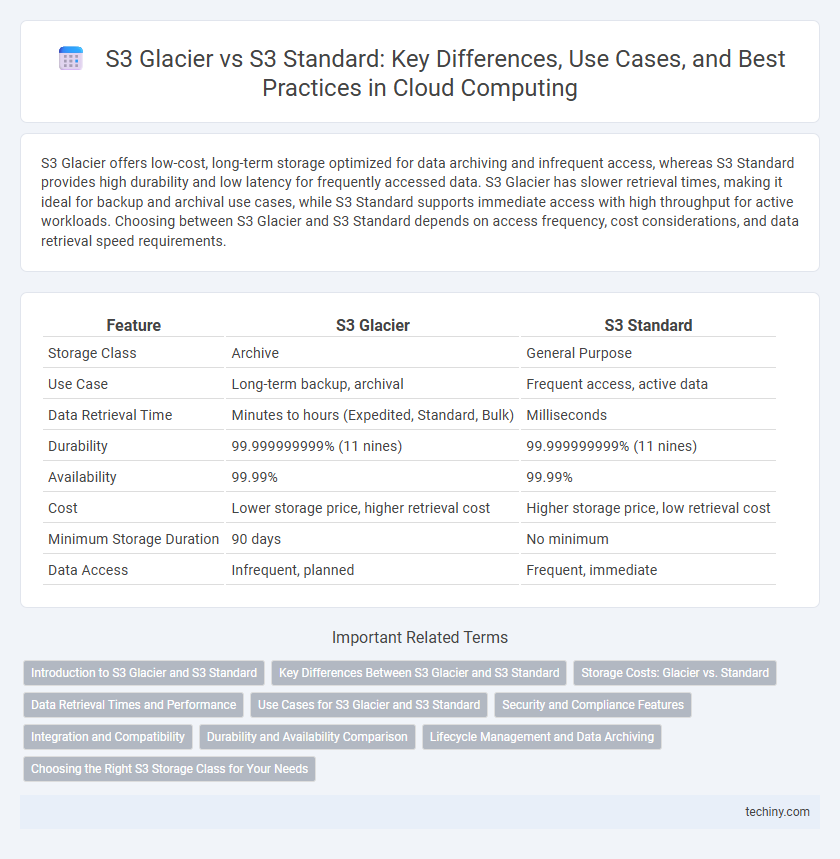S3 Glacier offers low-cost, long-term storage optimized for data archiving and infrequent access, whereas S3 Standard provides high durability and low latency for frequently accessed data. S3 Glacier has slower retrieval times, making it ideal for backup and archival use cases, while S3 Standard supports immediate access with high throughput for active workloads. Choosing between S3 Glacier and S3 Standard depends on access frequency, cost considerations, and data retrieval speed requirements.
Table of Comparison
| Feature | S3 Glacier | S3 Standard |
|---|---|---|
| Storage Class | Archive | General Purpose |
| Use Case | Long-term backup, archival | Frequent access, active data |
| Data Retrieval Time | Minutes to hours (Expedited, Standard, Bulk) | Milliseconds |
| Durability | 99.999999999% (11 nines) | 99.999999999% (11 nines) |
| Availability | 99.99% | 99.99% |
| Cost | Lower storage price, higher retrieval cost | Higher storage price, low retrieval cost |
| Minimum Storage Duration | 90 days | No minimum |
| Data Access | Infrequent, planned | Frequent, immediate |
Introduction to S3 Glacier and S3 Standard
Amazon S3 Glacier offers a secure, durable, and low-cost cloud storage solution designed for long-term data archiving and backup, with retrieval times ranging from minutes to hours. In contrast, Amazon S3 Standard provides high-performance, low-latency storage optimized for frequently accessed data and real-time applications. Both services integrate seamlessly within the AWS ecosystem, enabling scalable data management based on access frequency and cost requirements.
Key Differences Between S3 Glacier and S3 Standard
S3 Glacier offers ultra-low-cost, long-term archival storage with retrieval times ranging from minutes to hours, while S3 Standard provides high durability and low-latency access for frequently accessed data. S3 Glacier uses a vault-based system optimized for compliance and data backup with flexible retrieval options, whereas S3 Standard supports immediate access and is ideal for real-time processing and active workloads. The pricing models differ significantly, with S3 Glacier charging lower storage costs but higher fees for data retrieval compared to the premium storage and consistent performance pricing of S3 Standard.
Storage Costs: Glacier vs. Standard
Amazon S3 Glacier offers significantly lower storage costs compared to S3 Standard, making it ideal for long-term data archiving and infrequent access. S3 Standard provides higher pricing but supports rapid data retrieval and frequent access patterns with low latency. For cost efficiency, choosing S3 Glacier reduces storage expenses by up to 80% while sacrificing immediate availability.
Data Retrieval Times and Performance
S3 Glacier offers long-term data archiving with retrieval times ranging from minutes to hours, making it ideal for infrequently accessed data requiring low-cost storage. S3 Standard provides low-latency, high-throughput performance with millisecond retrieval times suitable for frequently accessed or real-time applications. Choosing between S3 Glacier and S3 Standard depends on the desired balance between retrieval speed and storage cost efficiency.
Use Cases for S3 Glacier and S3 Standard
S3 Standard is ideal for frequently accessed data, such as web hosting, content delivery, and real-time analytics, providing low latency and high throughput. S3 Glacier is optimized for long-term archival and digital preservation, supporting infrequent access with retrieval times from minutes to hours at significantly lower storage costs. Use cases for S3 Glacier include compliance archives, backup retention, and disaster recovery where data durability is critical but fast access is not required.
Security and Compliance Features
S3 Glacier offers enhanced security with built-in encryption at rest and in transit, supporting compliance standards such as HIPAA, PCI-DSS, and FedRAMP, ideal for long-term archival with strict regulatory requirements. S3 Standard provides strong security features, including encryption and integration with AWS Identity and Access Management (IAM), suitable for frequently accessed data needing robust protection and compliance. Both services support AWS CloudTrail logging and versioning, aiding in maintaining audit trails and regulatory compliance.
Integration and Compatibility
Amazon S3 Glacier integrates seamlessly with AWS services such as AWS Lambda, CloudWatch, and AWS Identity and Access Management (IAM), offering enhanced archival storage with automated lifecycle policies from S3 Standard to Glacier tier. While S3 Standard supports real-time access and immediate data processing for applications, S3 Glacier is optimized for long-term archival with compatibility for bulk data retrieval through RESTful APIs and AWS SDKs. Both storage classes maintain consistent APIs and security models, facilitating easy migration and integration within existing AWS ecosystems.
Durability and Availability Comparison
Amazon S3 Glacier offers 99.999999999% (11 nines) durability and 99.99% availability, optimized for long-term archival storage with infrequent access. In contrast, Amazon S3 Standard provides the same 11 nines durability but higher availability at 99.99%, designed for frequently accessed data with low latency. The key difference lies in access speed and cost efficiency, with S3 Standard supporting immediate data retrieval and S3 Glacier prioritizing cost-effective, durable storage with delayed access times.
Lifecycle Management and Data Archiving
S3 Glacier offers cost-effective long-term data archiving with archival storage classes designed for infrequent access, whereas S3 Standard supports frequent access with low latency. Lifecycle Management policies automate data movement between S3 Standard and S3 Glacier tiers, optimizing storage costs by transitioning objects based on access patterns. This integration enables organizations to archive data seamlessly while maintaining retrieval flexibility through configurable lifecycle rules.
Choosing the Right S3 Storage Class for Your Needs
S3 Glacier offers low-cost, long-term archival storage with retrieval times ranging from minutes to hours, ideal for infrequently accessed data requiring durable backup solutions. S3 Standard provides high durability, low latency, and immediate access, suited for frequently accessed, performance-sensitive applications. Selecting the right S3 storage class depends on access patterns, retrieval time tolerance, and cost efficiency requirements for your cloud data management strategy.
S3 Glacier vs S3 Standard Infographic

 techiny.com
techiny.com